Myanmar: Behind
the Bamboo Curtain
The first
question friends who know anything about Myanmar (Burma) ask me is: so whatís it like -- is
it really a backward, anti-utopian, basket
case country run by loonies enslaving locals?
When put this way, the answer is no. The
infrastructure is excellent, better than Laos and most
countries that have similar GDPs on paper.
The people are friendly, work hard most of the time, get along
with each
other very well within their community and get along normally with
their local
authorities. The money is in sane
denominations, no longer the 15, 35 and 90 Kyat notes imposed by former
dictator/numerologist Ne Win.
Life goes on as youíd expect to see anywhere
else in the region. There is indeed fear
of the regime and repression, as in other oppressive dictatorships. I witnessed traffic police harshly treating
traffic offenders, and I myself was confronted by an angry soldier who
thought
I was taking pictures of the bridge we were standing on. People
are very careful about discussion of
politics on the street, but they do, and are quite happy to talk about
it with
strangers, which surprised me.
Probably
the most serious human rights abuse accusation leveled at the ruling
military
junta is enslaving youth populations to do hard labour
work. While I have no doubt that this
does still occur, especially in the countryside and in
tourist-forbidden zones
of Myanmar, I did not personally see evidence of this.
It is fashionable to point out that the
digging of the moat around Mandalay palace was done by enslaved
residents. But another version this story
that Iíve
heard is that locals were forced to work one day a month, not unlike
obligatory
military service in other countries. So
how draconian is the regime, and how much of this is hyperbole? I donít know.

Burmese script on a monument
in Mahabandoola Garden in Yangon, with the Sule Pagoda in the
background.
I met
more or less free people that could do what they wanted, as long as
they obeyed
the highly corrupt and self serving authorities, of course. All Myanmar people insist that their country
is rich with resources, the richest in southeast
Asia. It is the regime that has bled off
the wealth of the nation, leaving little for the common citizen. But there are private citizens with quite a
bit of money, enough to buy cars and property.
Some of them undoubtedly have military connections.
One way the regime rewards soldiers is to
sell them precious gasoline rations at below-cost official prices (180 Kyats/gallon), which they resell on the black
market for
higher-than-free-market prices (over 2200 Kyats/gallon,
or $2.50/gallon). Many of the
wealthy
have worked abroad and brought back money to start businesses. You need money to do this of course. A work permit for South Korea costs 2.5
million kyats ($27000) in fees and bribes,
but 2 or 3
years of income could easily yield a healthy financial return upon
return home.
The major
roads are paved and in excellent condition.
There are street lights along stretches of main highways. Almost all buses are secondhand Japanese
models. The more modern buses running
the fiercely competitive Yangon-Mandalay line are
all
air conditioned with DVD video systems.
Hotels are in excellent condition, as in fact were most of the
buildings, which surprised me greatly. I
couldnít believe they had strong hot water and powerfully flushing
toilets,
plumbing that England for example could learn from.
A
new rail and road bridge between Mawlamyaing
and Mottama, which had to be at least 4 km
long, was a thing of
beauty. One local told me that all
this
is just a beautiful faÁade that the government has built to impress
visitors
(such as those currently attending this year's ASEAN conference hosted
in the
capital city of Yangon, formerly known as Rangoon).
But after over two weeks of poking around the
country, including to some slightly out of the way towns, I have
come to
believe that the infrastructure is in fact pretty good in Myanmar, much
better
than I expected. Other travelers I met
all agreed. I can't explain why that is so, but the lack of
destruction wrought by civil war, as was the case in Indochina,
probably helped. So whatever the
motivations
for the government are, these public service projects are helping the
people
and commerce as a whole. And commerce
does go on. Markets are as lively as
anywhere else in the region, and there is no shortage of goods. Good food is copious, diverse and affordable
to all, unlike in Cuba for example.
I donít
want to give you the wrong impression, though.
Daily living standards in Myanmar is
very low. All cooking is done by burning
charcoal,
purchased for 700 Ky
($0.75)
per giant bag. Natural gas stoves are
unheard of, because of course the vast natural gas reserves of the
country are
being piped into Thailand and fattening the cats of the Myanmar regime. Most people live hand to mouth from day to
day. This is perhaps best illustrated by
profiles of individuals:
My
trishaw (bicycle rickshaw) driver who delivered me from the Mandalay
bus
terminal to the city was a cheery chap who spoke good English. Many people are learning English themselves
from a book
as
a way to tap into the tourist money, which tells you how important a role tourists have come to play in local
economies. The asking price was 1500 kyats
($1.70), which Iím sure included a hefty foreigner premium, but was
fair enough
if he was going to cycle me and my backpack 10 km.
In fact, the central bus terminal of Yangon
is an even more ridiculous 27 km from the city, which is apparently for
government corruption reasons. He told
me he was very happy to have a customer that morning.
Some days he has no customers at all. With
the 1500 kyats
I paid him, he could feed himself and the owner of the bicycle. On a lucky day, he might have a second
customer in the afternoon. With those
additional 1500 kyats he could feed his
parents and
put money aside to pay the annual 7000 kyat licensing fee for operating
a
trishaw.
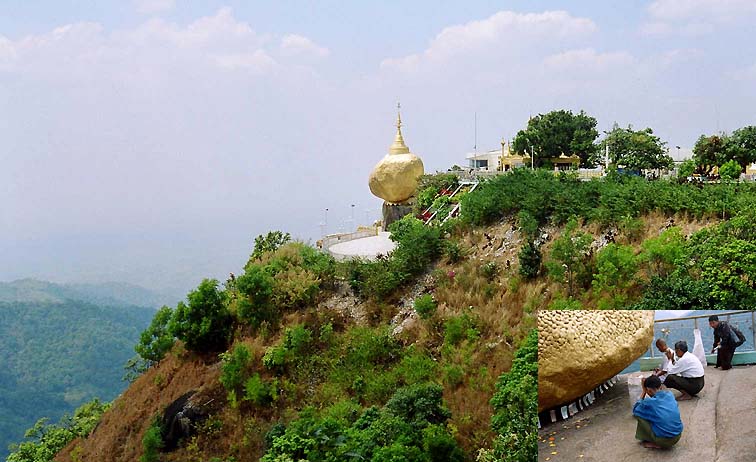
My
trishaw driver in Bago who took me around
to the
major sites in 2 hrs early one morning spoke excellent English. His 50-odd years made him less robust on the
bicycle than the Mandalay trishaw driver.
Clearly educated, I wondered why he was operating trishaws for
tourists. It turned out he was a primary
school teacher
who had to teach English among other subjects to his students. He quit 9 years ago because the state paid him
1500 kyats ($1.70) per MONTH, and that was
not enough
to feed his family. Apparently salaries
have since risen to 9500 kyats ($11) per
month, but
that is still well below the poverty line.
He once met a Thai primary school teacher who makes $100 month
typically,
with comparable expenses in Thailand as in Myanmar, and envied that
salary,
which would have allowed him to live very well indeed in Myanmar. I handed him the 1500 kyats
asking price for the tour and he appeared very happy with it.
I met 23
year old H.M on Mandalay Hill, a common place for eager students to
intercept
English speaking foreigners to practice conversation.
I later met him for tea at the home of U.T.W.
an older ruby trader who couldnít find work and is now perfecting his
English
to hopefully work in tourism one day.
U.T.W. is a de facto
mentor of many of the younger eager
students of the
Mandalay Hill club. H.M.ís
story was a poignant one. Impoverished
from a countryside family, he moved to Mandalay to learn English in
order to
find a way to make money. Staying at his
auntís home, he bicycles an hour everyday into Mandalay city to attend
English
classes at a monastery. 15 hours a week
of group instruction led by a monk, that
costs 1000 kyats ($1.10) per month, cheap
even by Myanmar standards. I attended one
of his classes, and students
were enthusiastic about speaking English with a visiting native speaker. Because of the tourist boycott, it is not
easy to land an American. On weekends,
he hits Mandalay hill to practice with foreigners.
Though not the most gifted student of
English, he is very motivated. When I
invited them to join me in visiting the temple hill of nearby Sagaing, H.M. declined.
I asked why. Because he couldnít
afford the 200 kyat ($0.25) bus fare, which of course I then paid for
him. We discussed his ambitions.
He asked me to send an email off for him, to
an Israeli army major that he had befriended some months back. The Israeli had promised to spring H.M. out of
Myanmar. I asked him how he was going to
get out of the country. He didnít know
but he reckoned he could walk into China and then into Thailand, where
the
Israeli could pay his airfare out to Tel Aviv and help him find a job. That was his plan, anyway.
I warned H.M. that it wasnít going to be this
easy, especially as he would be a purely economic refugee, but H.M.
didnít want
to hear that. He was going to do
whatever it takes to get out. I
sincerely hope he doesnít meet bitter disillusionment.
Such a nice, sincere, earnest fellow,
and probably not an atypical case in Myanmar.
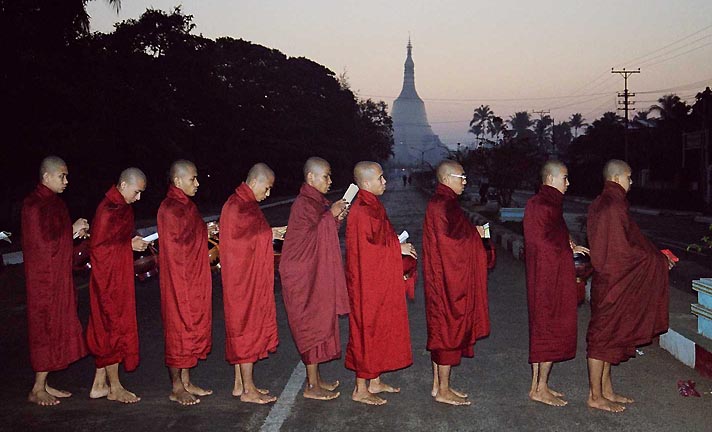
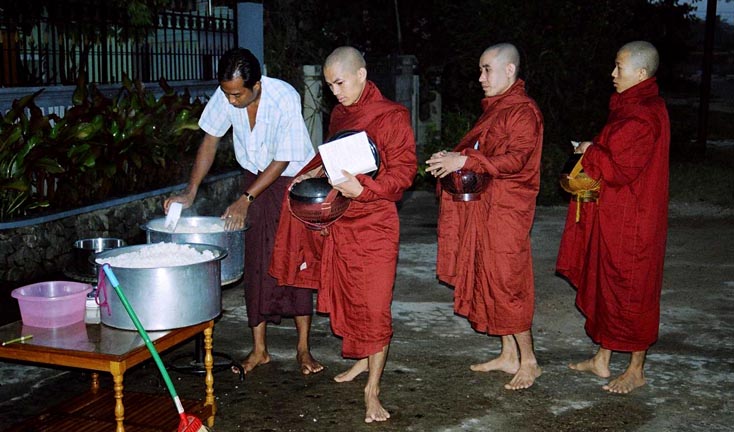
Should I
Stay or Should I Go?
Among travellers, there is probably more discussion of
morality
concerning Myanmar than surrounding any other country.
Should one boycott travel there? Should
there be an economic embargo? The
moralizing seems to outweigh the actual
body of firsthand information coming out of the country.
If there is one clear reason for going to
visit yourself, it's to tell others about
what Myanmar
is like. All of Myanmar, its people, its
places, its culture, and not just the military junta and its most
famous Nobel
laureate dissident under house arrest.
Granted, the typical tourist is afforded only a few weeks of
observations, but it's a lot more than what the rest of the world knows
about
Myanmar, which is shockingly little.
Remember that before Burma reopened to tourists in 1993,
outsiders had
barely even heard about, much less cared about the country. It was this reopening, economically as well
as to tourism, that ignited the current
international
debate and interest there. And that's a
good thing in every way.
Those who
understand me well realize how much I despise political correctness and
cults
of personality. For me it's all about the people, and what's best for
them in
the long run. Some of the most
experienced and interesting travellers
I've met on
the road have also share this curious apolitical stance toward such
entrenched
issues. Call it moral relativism if you
will, but I'm not seeking to create any Darth Vaders
or Jesus Christs here.
The main
reason for calling to boycott tourism in Myanmar is, as far as I can
see,
because Aung San Suu
Kyi and her National League for Democracy
party have called
for it, in order to deprive the ruling junta of this foreign income
source and
to ostracize them under the glare of the international eye. Aung San is
the
daughter of the martyred father of modern, independent Myanmar,
assassinated by
rivals shortly before formal liberation from the British empire. She has
since valiantly opposed the military
dictatorships and repression that has beset her homeland for the last
half
century, and I admire her courage and stubbornness.
One has to have both to win that
fight. And she has the people's support
as well. She won the 1990 election that
was annulled by the ruling junta. Those
Myanmar citizens I've talked with (behind closed doors of course) see
her as
their shining hope and inspiration. And
how can one put a price on inspiration?
One man in his 50s, who's seen the whole run of bad times, calls
her
"My Lady" with a twinkle in his eye, and I knew to whom he was
referring. When I hear Aung San mentioned in public by tourists, the
usual reactions
you get from locals are either a vociferous downplaying of her out of
fear of
being drawn into that dangerous discussion ("their spies are
everywhere" I heard on many occasions), or else silence with that same
twinkle in the eye. Every great revolution
and liberation from tyranny needs its heroes, and Aung
San fits the bill impeccably. How she
fares as national leader afterwards of course is a different story, and
one
that is too far away on the horizon to seriously contemplate now. I'm not much into idolatry and remarkably
similar stories involving Benazhir Bhutto,
Indira Gandhi, Corazon Aquino
and
Megawati Sukarnoputri do not portend well. In
any case, the coming of such a transition phase is inevitable,
necessary, and
very welcome.
Many
other notable anti-government dissidents, who also admire and respect Aung San, do not share her emphatic call for a
boycott on
tourism. They view this as an unfair
punishment on the impoverished people, who would be denied the
opportunity to
make a dollar or two from tourists, for an idealistic and thus far
phantom goal
that has eluded generations of ordinary Myanmar people.
Is she selfish to use her clout to press for
a heroic overthrow of the brutal regime, at the expense of the
suffering of her
people? Is she the queen born with a
silver spoon in her mouth, who has never known what it is like to
suffer in
abject poverty with no hope or chance to advance one's
owns modest desires and needs? Does she
hate the regime so much that she's basing her decisions based on hate
rather
than love? Of course, I can't even
pretend to have any informed thoughts on these rhetorical questions. I was just a tourist for 18 days who hasn't
even read her writings, but I just like to consider both sides of any
debate. I never did like the concept of
political debating, where it seemed that you had to be all white or all
black in
order to play the game correctly. It's
just not me.
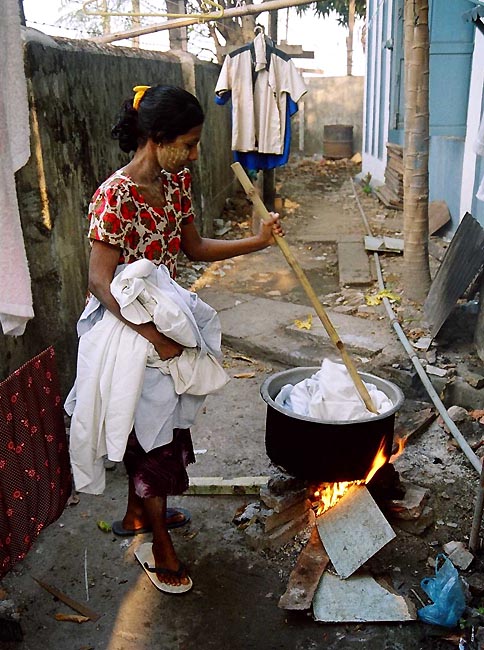
The real
question is: does the tourist money directly help the junta repress its
people? My conclusion is no, backpacker
spending is a drop in the bucket, and will affect the people positively
overwhelmingly more than negatively.
Package tourists spend a lot more money, and more of their money
goes
directly to the government, so that involves a different equation, but
I don't
know the numbers on that. OK, letís look
at the money. It used to be that travellers arriving in Yangon airport (until
recently, the
only legal point of entry for tourists) were obliged to exchange
US$250, 200,
or 100 for Foreign Exchange Certificates (FECs),
dollar-equivalent notes that had no value outside of Myanmar. FECs were not reexchangeable for hard currency upon exit from
Myanmar,
and thus your money stays in the country.
The government then would exchange these FECs
for local Kyats at an artificial rate
about a hundred
times worse for you than the black market rate.
They would thus pocket 99% of your money, unless you knew to
seek out
the black market. This FEC system is now
abolished, and there is no pressure on visitors to exchange dollars at
official
rates (which still suck). It is easy to
exchange money on the black market in any town, and this even appears
endorsed
by the government. So we've come a long
way in a decade. Today's backpacker
sporting the new FIT (Foreign Independent Traveller)
visa can spend their money any way they wish.
They can avoid spending the money directly on government
companies and
institutions if and when they choose.
Some idealists go out of their way to avoid any such spending,
and I
respect their choice. I would say I'm a
typical backpacker as far as government spending goes.
Let's break it down:
$25
Myanmar visa in Bangkok
$10 Bagan
entry fee
$5 Shwedagon
Pagoda entry fee
$5 Sagaing/Mingun
tourist boat and entry fee
$6 Kyaiktiyo
golden rock entry fee
$3 Inle
Lake entry fee
$3 Shwe
U Min cave pagoda entry fee
$10
international airport departure tax
So I
spent a gross total of $67 directly to the government.
That's of course not taking into account real
maintenance costs paid for by the government (such as at Bagan,
which is not a world heritage site and does not receive UNESCO
funding because the regime will not accept the conditions imposed by
the UN for its inscription). Some
travelers spend less money,
by not
entering certain sights or by evading entry fees (sometimes risking
arrest of a
private citizen if caught, which I do not approve of).
Some spend more, especially those taking
trains, whose inflated tourist prices go directly into government
coffers. Generally, by avoiding trains and
not buying
gems at government gem shops and not staying at government hotels
(which are
expensive and suck anyway), that minimizes how much money the
government is
taking from you. You're going to be
spending $50 minimum and most likely over $60, so that should be your
benchmark
when making your own moral decision about visiting Myanmar or not. There is also the issue
of indirect spending going to
the government, such as on transportation petrol surcharges, and hotel
head
taxes, but after talking with many owners of hotels, bus companies and
restaurants, I've concluded that the indirect contribution to the
government is
quite small. For example, the hotel head
tax is 10 kyat (about $0.01) per person per night.
Most of the inflated differential foreigner
prices, which infuriate some budget travellers
to no end, is pocketed by the private
interests and not passed on to
the government.
What do
the local people think? I didn't meet a
single one who supported the tourism boycott.
Whether they worked in the tourist industry or not, whatever
their
political views are (or are not), whether they were from places that
benefited
from tourists or not. The absence of
British commonwealth citizens and Americans
is very
noticeable, and the locals notice it too.
Curiously, this makes the demographic population of backpackers
in
Myanmar resemble the Axis: Germans,
Italians, Japanese, and Vichy French!
(That's a joke.) There is visibly
more money in the neighbourhoods that
tourists frequent, and they are bringing in
significant amounts of
cash to private business interests.
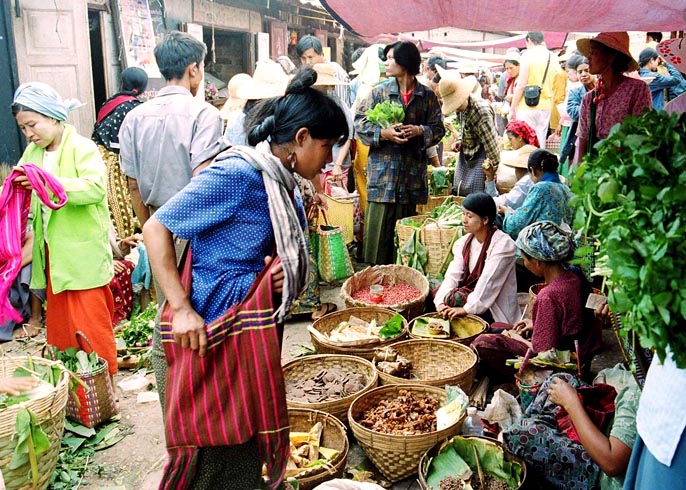
Market day at Pindaya, a
mountain village in the Shan state better known for its Shwe U Min
Pagoda, a cave containing 8000 golden Buddhas.
I estimate that there
were maybe a couple hundred backpackers in Myanmar when I was there,
which
was
toward the end of summer peak season.
Everybody goes by the same handful of transport routes and the
occupancy
rate of foreigners in intercity buses is still very low, even between
major
sites. You run into the same
tourists repeatedly. So I'll take a wild
stab in the dark and
guess that there are maybe 1,000 backpackers a year these days, though
this
number is definitely on a sharp rise.
Because of the abolition of the FEC system, word of mouth about
Myanmar
will only build up because it is the next "untouched" nation in
Southeast Asia. I'd say that Myanmar has
already inherited this mantle from Laos, and the most
touristy parts of Myanmar are already being noticeably spoiled. (Which is good for the locals don't get me
wrong -- I'm just speaking about tourist value.) So
at $60 from each backpacker, the
government makes $60,000 a year from all backpackers.
Enough for two of those Toyota Hiace
pickups that they somehow stuff 35 passengers into
(and onto and hanging onto)?
Considering
that the government is one of the biggest opium peddlers in the world,
monopolizes one of the richest teak and gem troves in the world, and
exports
petrol and natural gas to China and Thailand, a schoolchild can do the
math and
tell me how much backpacker ticket receipts are generating for the
junta. I went through this whole scenario
here
because I am often confronted by questions about whether it is "OK"
to go to Myanmar. Obviously, this is a
personal decision that everyone must make for themselves, but my point
is here,
your hard cash contribution to the government should not be the
dominant
reason. I find it really funny how
people who won't visit Myanmar for fear of enriching a repressive
government
may not entertain the slightest qualm about visiting Cuba, also a
country which
opens to tourists for the sole purpose of generating cash for the
dictatorship
(and much more cash per person than Myanmar, I might add), and which
represses
its people just as brutally, and where overall conditions of life are
far worse
than in Myanmar. It's not question of
democracy either.
There are plenty of dictatorship states that are popular
among
backpackers: Singapore, Vietnam, Nepal at this sad point in their history, Jordan,
Morocco,
and China to name a few. I have to
conclude
that the special case of Myanmar as backpacker pariah stems primarily
from the
heroine Aung San Suu
Kyi and her noble cause and has been
romantically magnified
by political correctness and righteousness and fuelled by the media.
Some
western anti-government protesters even insist on calling the nation
Burma and
not Myanmar, for the sole reason that it was the ruling regime that
made the
official name change in English in the 1990s.
It's rather petty and has nothing to do with reality. Burma was the British colonial name,
bastardized from Bamar, the name of the
dominant
ethnicity in the country. There are
however many ethnicities and cultures within the country, and hence it
is the
Union of Myanmar. Myanmar is how all
Myanmar people call their own country in their own language (or sounds
more
like "Myanma" actually), so why shouldn't
we? Regardless of who finally instituted
the change. A no brainer for me. To insist that calling the country under its
colonial name is more morally correct is a bit patronizing. Ironically, it seems to me that many of those
who refuse to acknowledge the name Myanmar are British.
The
current US-led commercial embargo against Myanmar has more serious
ramifications than pocket change from backpackers.
I am not an economist and I do not know how
this affects the economy and ruling stability of the government. It is certainly bad for the Myanmar people in
the short term. The question is whether
it will have positive long term repercussions.
My view on the current situation is that the embargo is having
little
effect on the ruling junta's grasp on power.
They have a close and powerful neighbouring
ally in China who can furnish Myanmar with anything it needs. As I mentioned, Myanmar also exports natural
gas to Thailand, and not a small amount of it.
Thailand's refusal to participate in isolating the Myanmar
regime has
led to diplomatic heat from other ASEAN nations. But
this doesn't look to change soon, and
even if it does, this is secondary to the Chinese connection. Myanmar is still selling a lot of gems to
Europe, mostly Germany, Austria and Switzerland, and the supply is
finding its
way into international markets. And
finally there's the opium money, which is rumoured
to
represent up to half of Myanmar's real gross domestic product. On a financial level, I don't think the
embargo has much hope of working in the current circumstances. Locals attribute rapidly increasing prices in
Myanmar on basic products to the embargo.
I don't know if that's true, since most of these products are
manufactured
in Thailand and China anyway, but if so, it would be an example of how
an
embargo can hurt the people without helping them in any real way, short
term or
long term.
You can't
compare Myanmar to South Africa. The
embargo had emotional consequences on Pretoria beyond the already
strict
financial ones (because they had no China to help them).
White South Africa never felt at home in
Africa, and didn't view their black neighbours
as
brothers in their shared destiny.
Rather, they looked toward their white motherland, Europe, for
support
and nourishment and even identity.
Mother Europe participated in the South African embargo,
isolating South
Africa as much emotionally as anything else.
They cared too much about being white and British for this not
to have
taken its toll. It was only a matter of time before a white leader (DeClercq) caved in.
Myanmar doesn't have this identity issue. They
have a proud independent, ancient, and
unified history, before and after colonialism.
They are Myanmar, not an offshoot of Britain, and so they cannot
be scolded
and lectured as pariah children. Only
the intellectual elite in Myanmar might possibly suffer from this sort
of psychological isolation. I don't think
anybody else
in the country,
least of all its regime, gives a hoot about world political opinion of
Myanmar. The people care mostly about
surviving from day to day these days, and trying to improve their lives.
And you
can't compare Myanmar to Iraq. Oil was the
sole source of income for Saddam Hussein's government and with
the
exception of a bit of oil trickling through a secret pipeline through Jordan and UN scandals, he didn't have many
outlets for his
product. As a result, the regime was
financially crippled and the military was ill equipped to survive the
eventual
US invasion. I'm not making political
statements here, just commenting on the relative effectiveness of the
embargos.
I am disturbed, though, that some people might have been against the
Iraqi
embargo because it was hurting the people, but at the same time for the
Myanmar
embargo despite the fact it is ineffective and also hurting the people.
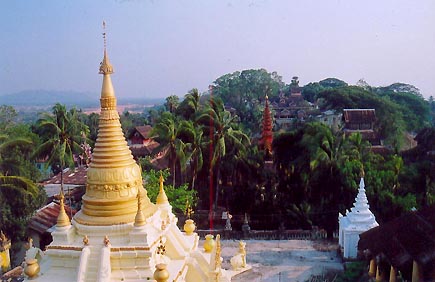
The Land
of Golden Pagodas
OK,
enough of that stuff! What's there to
see in Myanmar? Plenty!
The limiting factor is normally the 28 day
visa, and not the number of interesting places in the country. It is not possible to see even all of the first rate sites in Myanmar. Everybody leaves having missed out on some of
the major destinations. The absolutely unmissable places are Bagan,
Inle Lake, and the Shwedagon
Pagoda in Yangon. Thatís what the
guidebooks say, and I agree with them.
The only
rival to Angkor in the world of ruins is Bagan.
Rather than in artistic quality and
romantic
settings, Bagan overwhelms you with the
sheer number
of pointy temples within a few square kilometers. 4
million of them by legend, 4 thousand of
them according to temple geeks, and undoubtedly not all of those have
survived
in a preserved state. Whatís left is
still enough to be mind blowing. And I
didnít count them. In 1996 I wanted to
visit one of the worldís spectacular sites, and my final choice came
down to
Angkor or Bagan. I
chose Angkor with no subsequent regrets, but
Bagan wouldnít have been a bad choice
either, especially
considering how truly special it would have been at that time to have
visited
Burma.
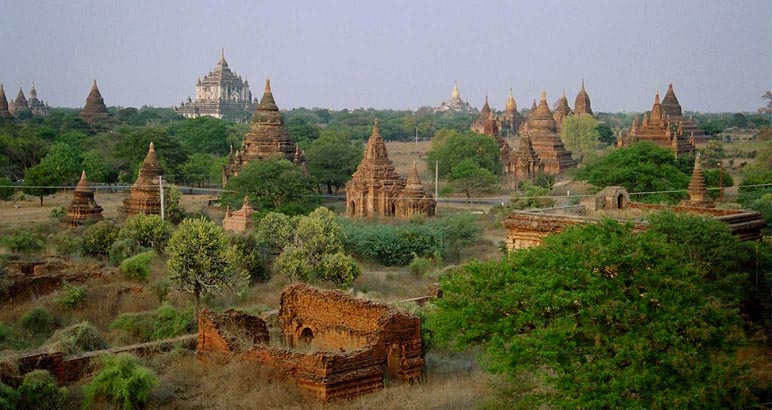
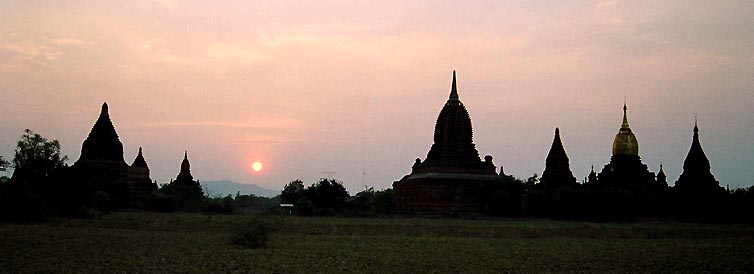
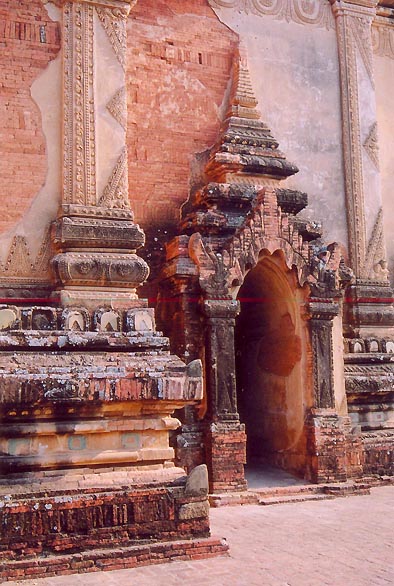
Bagan in the daytime as seen from the Mingalazedi pagoda (top), at sunset from near Shwesandow pagoda (middle) and detail of a door of a minor temple, Hti--lo-min-lo (bottom)
Inle Lake is a more lowkey attraction, which does
not strike acutely at your senses, but rather slowly invades them over
a day of
boating around this veritable real life Waterworld.
The entire economic and social life of the
towns and villages on the banks of and floating on Inle
lake takes place on the water, especially on its western shore, which
is
essentially half-marshy land and half-lake. It
is a seamless and intercalated maze of
waterways, canals, bridges, foothpaths,
boat landings
and wooden houses hovering over the lake surface on poles.
There
is no need nor facility for accommodating
automobiles,
and the sound of their absence is palpable. Public
and tourist transport around the lake
takes place through motorboats, but the majority of boats plying the
lake
between the villages and for fishing are still motorless.
The image of villagers poling their way
down the canal with one leg coiled around the pole for leverage is the
subject of postcards. It is
difficult for me to describe how impressive Inle
Lake
really is. The scope and breadth of the
lives of thousands of people dependent on the lake is what sets this
apart from
other floating village-type attractions in the world. Inle is not
spectacular in the usual sense of the word, but no less essential and
satisfying to visit.
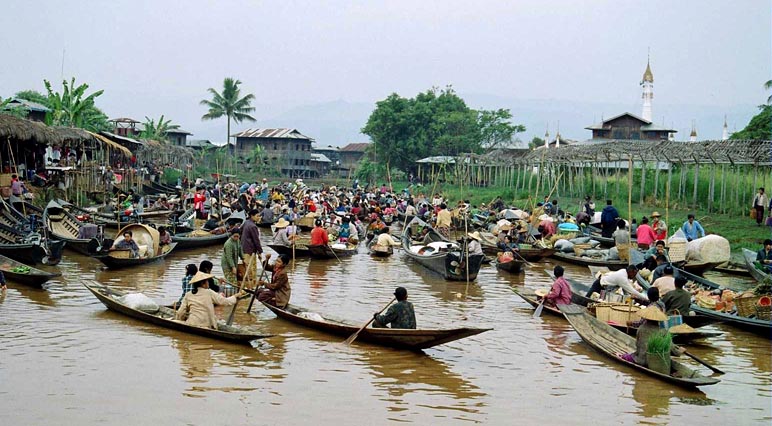
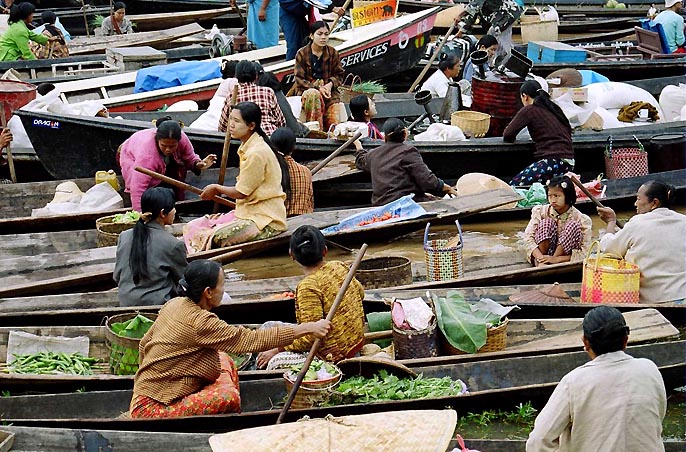
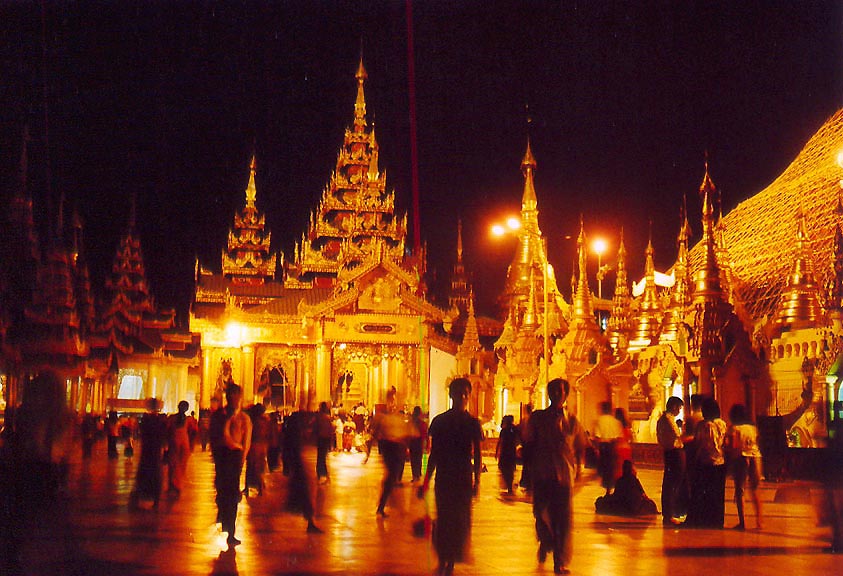
ďIf You Hit the Jackpot, Eat ChineseĒ
So goes one Burmese
proverb, which I fear doesnít give enough
credit to Myanmarís own home cuisine, a distinct southeast Asian
smorgasbord of
dishes combining Indian styles with Chinese, and Thai influences. Another modern proverb spelling out a commonerís
paradise Ė Eat Chinese, marry a Japanese girl, and live in Switzerland
Ė only goes
to show what kind of cultural heterogenity exists in Myanmar after
centuries of
building and losing empires. This
confusion certainly extends into Burmese food.
I have to admit, itís one of my favourite cuisines in the area. The tempering of Thai and Indian spices with
Chinese influences, and conversely the spicing up of the dishes in the
ethnically Chinese Shan state by Indian and Indochinese influences,
creates delightfully
pleasant taste combinations. Food is
good and so are the portion sizes. One of
my
favourite restaurants was in Baganís base town of Nyaung
U. Mann
Sabai serves up their chicken curry with 11 different small vegetable
side dishes,
soup, tea, and all you can eat steamed
rice (standard practice in Myanmar). All
for an all inclusive price of 900 Kyats ($1). Delicious
biryani plates sold on city streets sell
for about 400 kyats. So if thereís one
thing travellers canít complain about in Myanmar, itís the eats. On the drink side, local brews Myanmar and
Mandalay beers werenít exactly world class, but I became addicted to
refreshing
Star Cola
(100 kyats per bottle) on hot sunny afternoons.
Searching For MíLady
On my last day in
Myanmar, I had a few hours in Yangon and
had to satisfy my curiosity about one thing.
I hopped on the all-purpose city bus #43, which links downtown
with the
two lakes, the airport, and the highway bus terminal, and costs a mere
20 kyats
($0.02). I got off at Lake Inya and
walked to the intersection of University Avenue Road, where this sign
stands:
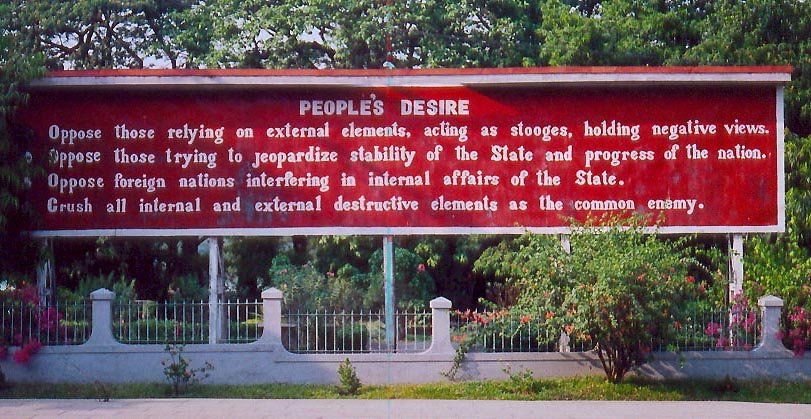
From the map on my Letís
Go guidebook, I located where house
#54 should be, the lakeside home of Aung San Suu Kyi and where she is
kept
under permanent house arrest. Whether
she was actually there or not is a different matter, as all kinds of
rumours on
her whereabouts fly about. I
walked down the street a hundred meters or
so, and saw a traffic road barrier manned by police. As
I came within sight of them, a plainclothed
man on the street whistled to signal to someone. I
kept walking toward the barricade, where
officials inspected each passing car before allowing them to pass
through this
busy road. I
spotted a cold drinks shop only a few meters
in front of the barricade, so I decided I needed a Star Cola. I was in fact thirsty. By
the time I arrived and communicated my
thirsty ideas to the shopowners, I was surrounded by a motley crew of
uniformed
and non uniformed men. None of them said
anything but neither were they unpleasant. Of
course I was interrogated about where I was
going and innocently stated that I was interested in seeing the
University,
which was further down the road. They
told me politely that the road was not passable. When
asked why, the unique reply was ďI donít
know.Ē What were those military people
doing there? ďI donít know.Ē
What
are you doing here? ďI donít know.Ē At
that point I realized thatís all I was going to get out of anybody (the
shopowners
did not appear at ease with this discussion though they were quite
friendly to
me like most Myanmar people). So I went
on my way and visited a few more tourist sites by bus in Yangon before
retiring
at the White House hotel for my last night in Myanmar.
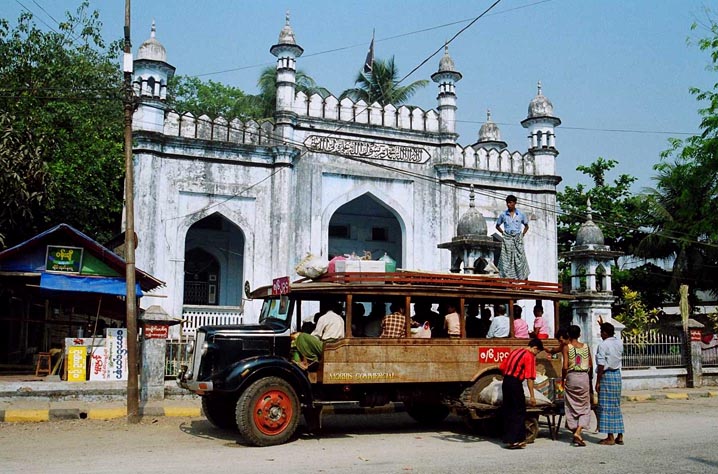
A
linecar is a typical public transportation vehicle in the former
British colonial capital of Mawlamyaing, though pickups are far more
common in larger cities and smaller towns.
There is so much more I
could talk about with respect to
Myanmar, but I hope this at least piqued your curiosity about one of
the most
fascinating and overlooked countries in Asia. It
was one of the most important target
countries for me on this trip and it didnít disappoint.
There is plenty enough to see on a second
trip one day, but I fear it will already by overrun by tourists by
then. The opening up of the country to
foreigners,
outside information and international commerce can only pound the wedge
deeper into
the cracks of what was once one of the most fearsomely closed nations
in the world. When you see private locals
bypassing
internet restrictions and watching live CNN and BBC world news on their
satellite dishes, you get the feeling itís only a matter of time before
they
integrate into a normal rhythm one day. Now
it certainly wonít be easy Ė take a glance at Beijing Ė but I am an
optimist,
and I left Myanmar smiling as much as their citizens smiled at me.
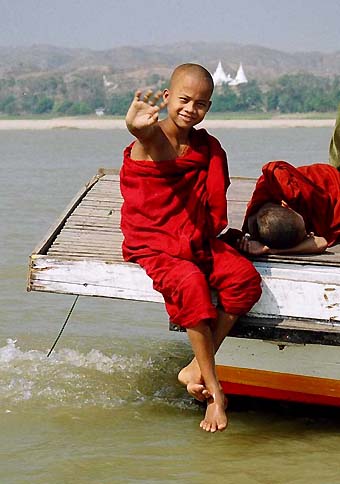
Boy monk on an Ayerawaddy
riverboat heading upstream from Mandalay.